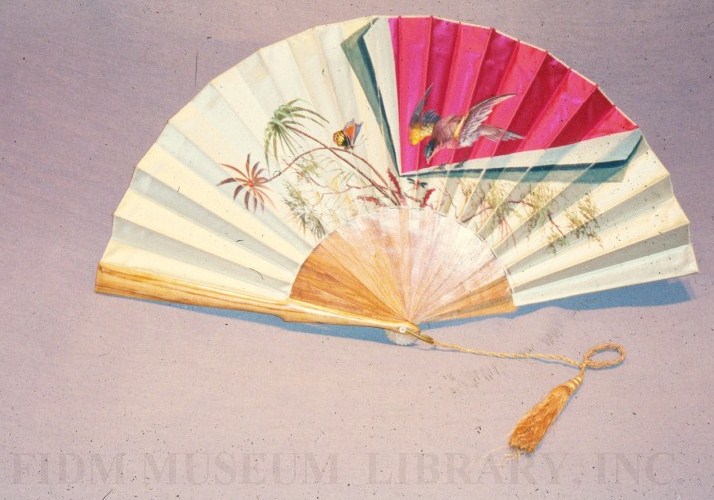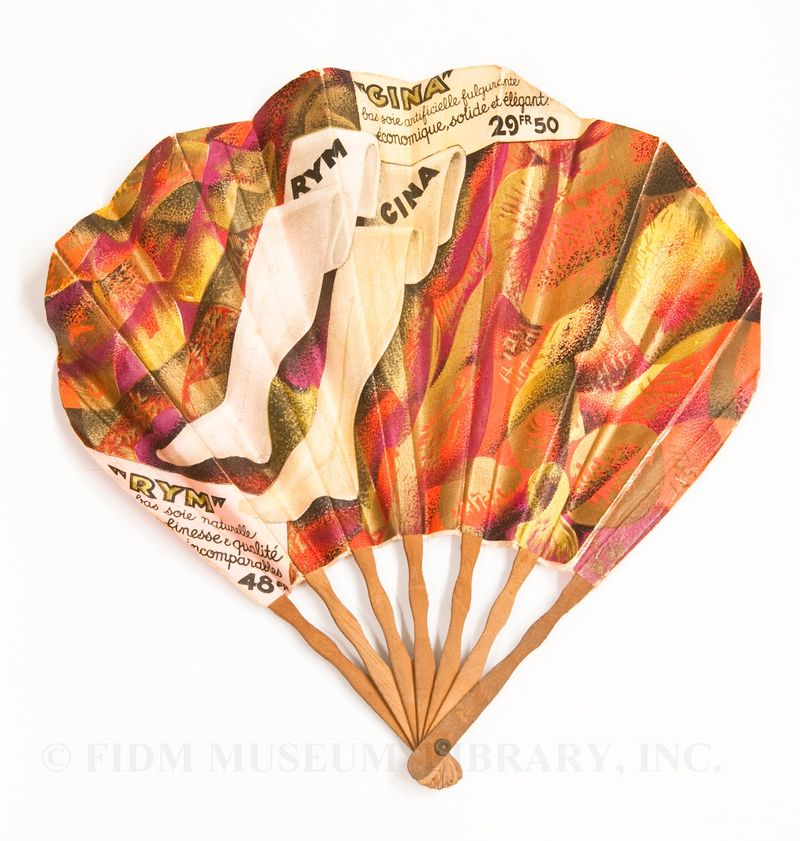During an early summer trip to Japan several years ago, I was fascinated to see that folding paper fans were more than just a tourist souvenir. Stores of all types and sizes sold paper fans printed with imagery ranging from cute children's characters to scenes borrowed from iconic woodblock prints. It quickly became obvious that many women, and even some men, actually used these fans to create a small breeze in the punishingly humid Japanese summer weather. I even purchased a fan and used it frequently during my trip. On returning to the US, I tried to use my fan with the same unselfconscious freedom I had enjoyed in Japan. Given the complete absence of folding fans in contemporary western culture, I eventually caved. My paper fan is now tucked away in its patterned silk case, awaiting my next trip to Japan.
My experience in Japan highlights the position of folding fans within western culture. Though once considered part of a complete wardrobe, fans are now almost entirely archaic and very rarely used. Contemporary representations of folding fans usually symbolize the past, or suggest a link with Asia. This may change with the rebirth of Duvelleroy, a Paris fan maker established in the early 19th century. Duvelleroy was once the premier fan maker, creating fans for European royalty and collaborating with artists and couturiers to create fashionable fans. Will the new Duvelleroy generate a surge of interest in folding fans? Readers, what would it take to make you carry and use a fan?
 Hand-painted fan
Hand-painted fan
Silk & wood
1885-1895
Gift of Carol Richards
96.601.1
Paintings and clothing inventories indicate that rigid fans, often made of feathers, were used as fashionable accessories by well-to-do European women in the 16th century. Folding fans weren't widely known in Europe until they were brought back in small quantities by travellers who had journeyed to Japan and China; this probably occurred sometime in the late 16th century. By the late 17th century, European manufacturers had mastered the folding fan.
Like the hand-painted silk fan pictured here, the earliest European folding fans were hand-painted paper or silk. Later fans featured a variety of printed images, ranging from pastoral scenes to fans printed with rules of popular card games, dance steps or historical facts. Given their association with Japan and China, imagery evocative of these cultures frequently appeared on fans. With its hand-painted motif of birds and bamboo-like foliage, the fan pictured here is clearly meant to suggest Japanese or Chinese scroll paintings. Almost certainly crafted in the west, this fan dates from the late 19th century, when a wave of interest in all things Japanese swept Europe and North America.
By the 1920s, folding fans were rarely used as fashionable accessories. Though extravagant feathered fans were a popular complement to slim 1920s evening dresses, fans rarely made an appearance during the day. Retailers and advertisers, however, frequently used inexpensive folding paper fans to promote their products. Throughout the 1920s, Parisian department stores were especially prolific in the production of advertising fans. Fans printed with advertisements were given away for free with a purchase or as a promotional event in itself.
 Advertising fan
Advertising fan
c. 1930
Paper & wood
Museum purchase
2004.5.20
This fan promotes the Galeries Lafayette, a Parisian department store established in the 1890s, with the bold slogan, "I buy everything at the Galeries Lafayette." The reverse of the fan sings the praises of two types of stockings: Gina and Rym. The Gina is an "economical dazzling artificial silk stocking, strong and elegant," while Rym is a "natural silk stocking [of] incomparable fineness and quality." The unique shape of this fan, peaked in the middle and shorter on the sides, is called a balloon or fontange shape. Due to it's popularity throughout the decade, it can help date folding fans to the 1920s.



I carried a fan all last winter and spring, and used it whenever I had a hot flash.
loved seeing those fans. I have fans all over the house and in my purse. and I use them all the time. they’re not real fancy but they serve the purpose. I’m not too concerned what people think about it.
The only problem I have with carrying/using a folding fan is managing not to lose the ones that I like!
Here in the midwest fans are still widely used, especially in rural areas.
Many rural churches don’t have air conditioning and you can find a basket of stick fans in the back of the sanctuary or in the racks with the hymnals.
They are also very popular at county fairs. These fans are usually a freebie from a media outlet and often have the face of a local tv celebrity on them in bigger towns. In smaller towns they are more likely to be freebies from a bank or insurance agency with their advertising on them.
I rarely see folding fans. When I was younger older ladies often carried them, along with their delicate hankies used to blot at glowing faces.
I carry a folding fan in my purse that was my great-grandmother’s. I do use that in the summer when we are working outside (husband is an entertainer and we spend most of our summers at county fairs).
Love hearing all of these fan stories!
Gracie, it’s especially interesting to hear your thoughts on fan usage in the midwest. Given the hot midwestern summer weather, it makes sense that fans would still be used more commonly there.
I had a similar experience in China when I visited. Cheap fans are sold everywhere, and everyone uses them. I was also recently in Spain and they are also sold everywhere there too. My Spanish friend told me they are fairly commonly used when it’s hot there too. I wish they were used more in the US – they’d come in handy in the DC summers!
I actually do carry and use them in the summer. I’ve found them invaluable for surviving the Chicago summers. I find them in Chinatown for like, 2 dollars, I’ve got at least five!